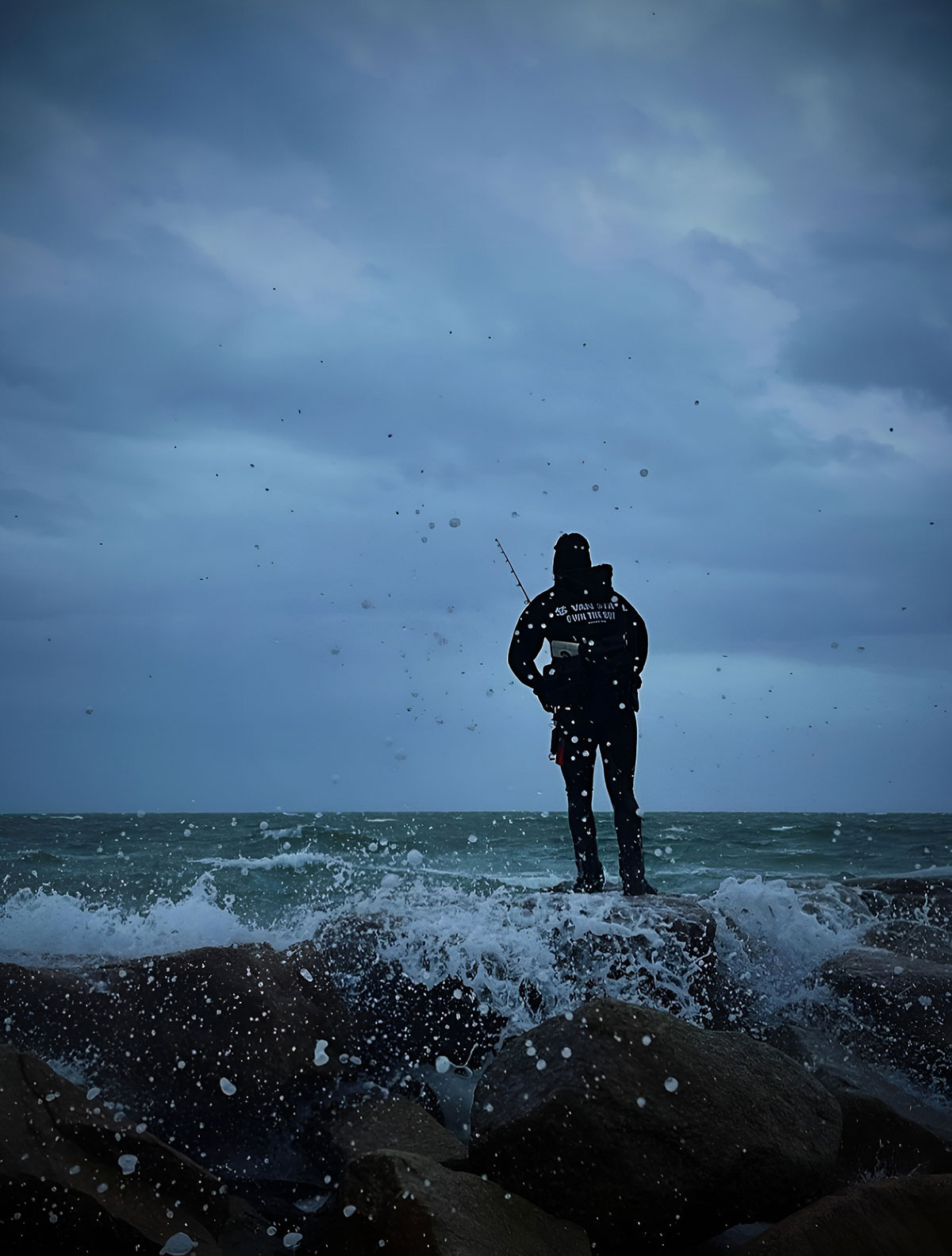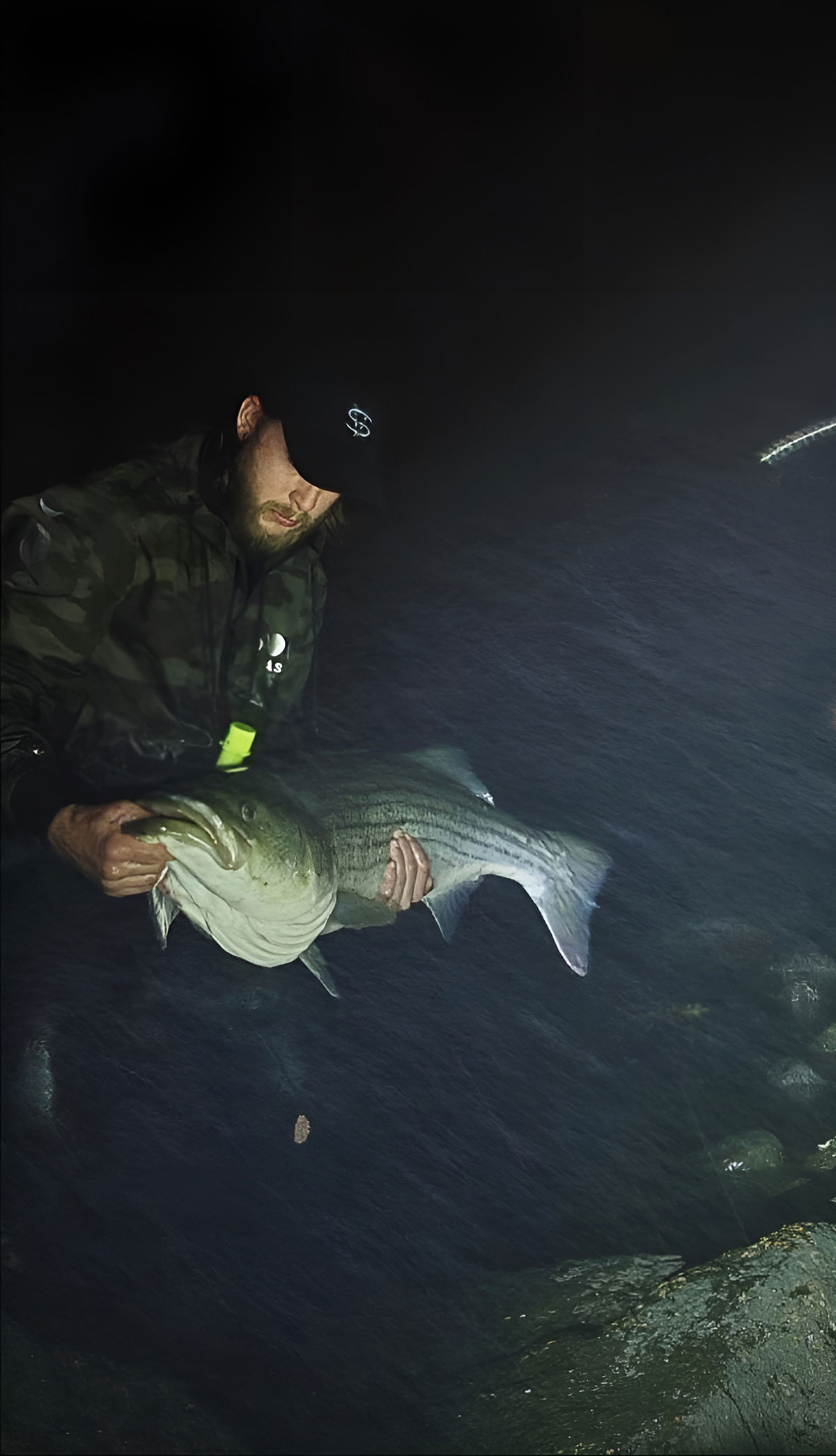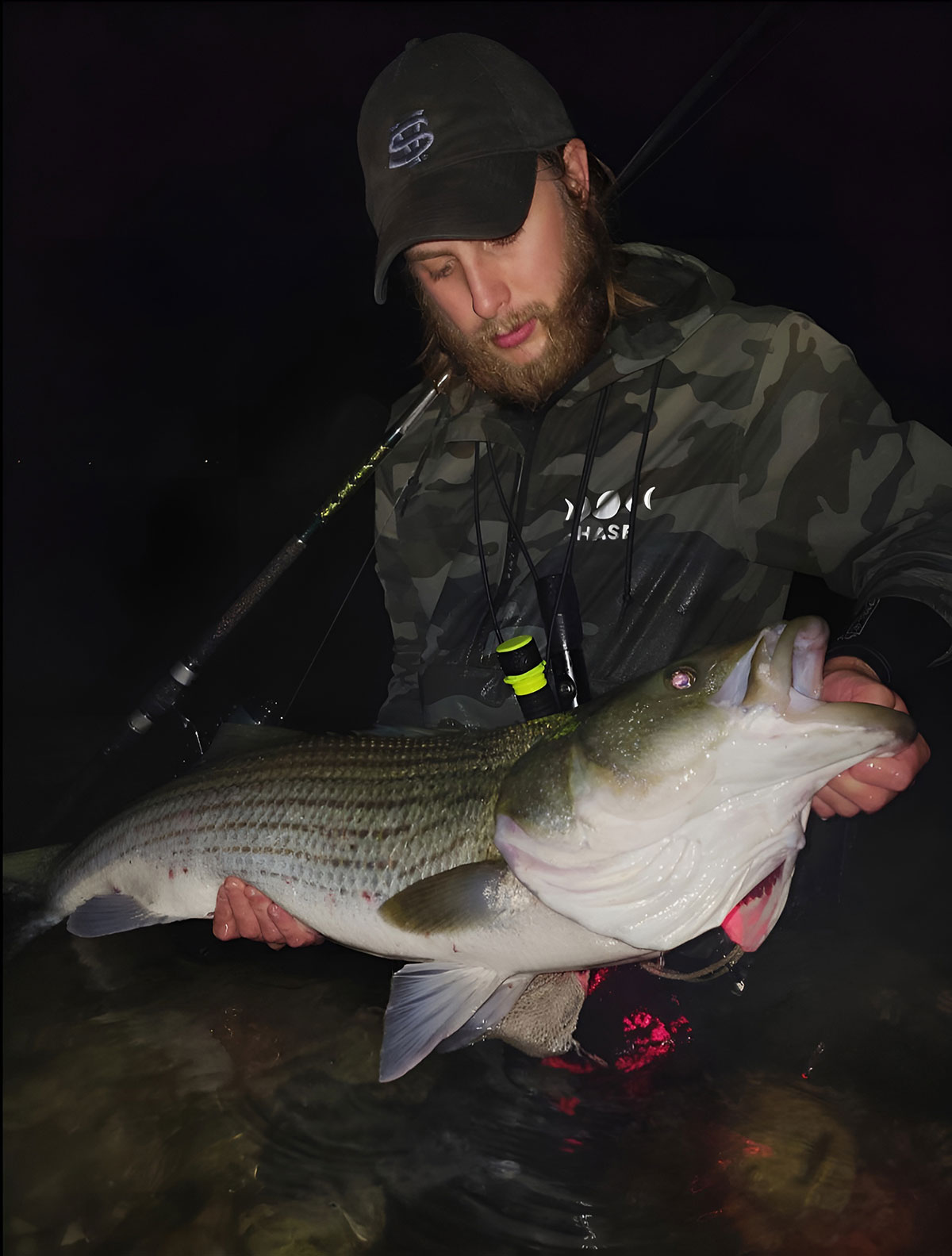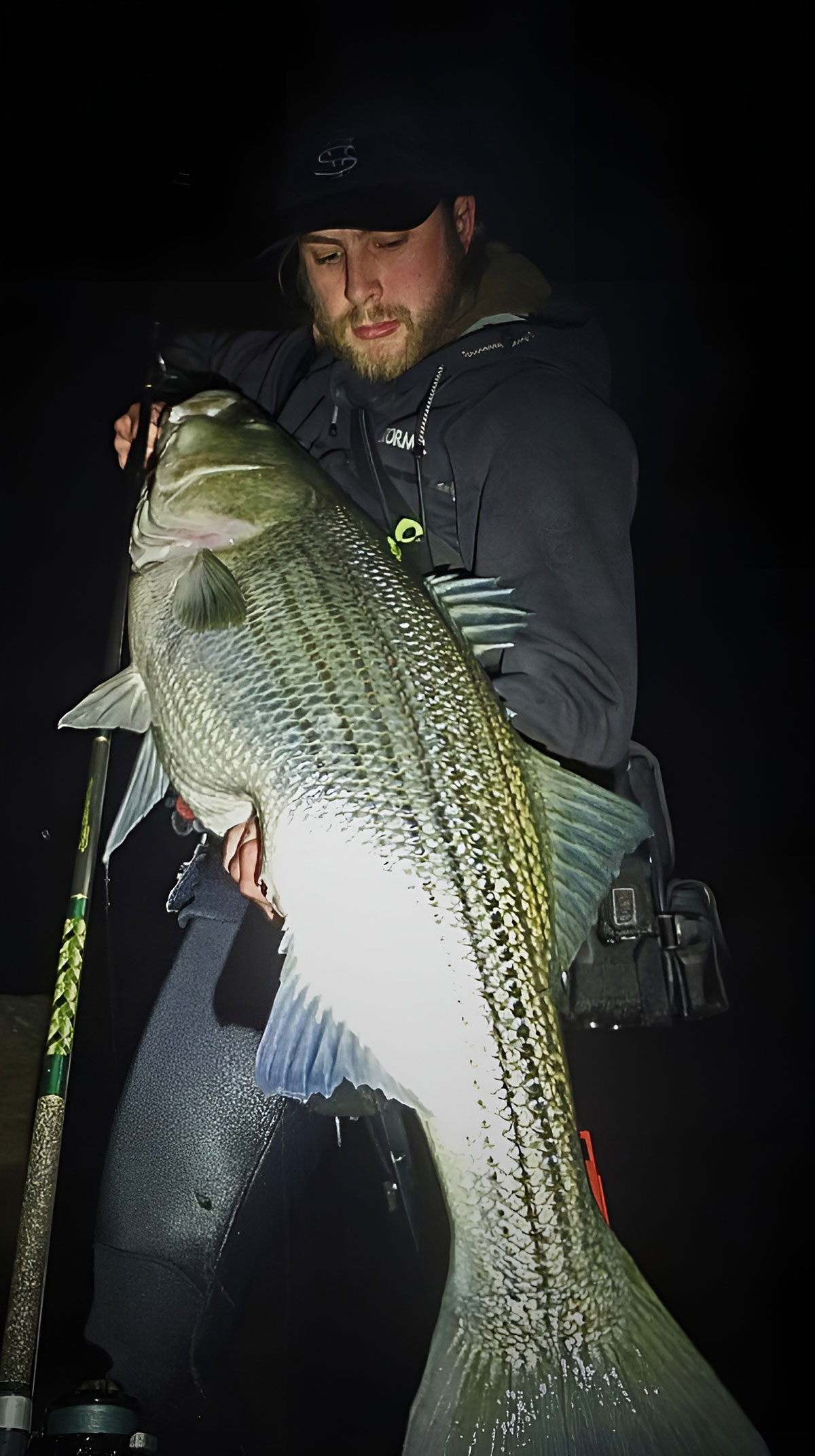
Heavy winds and big waves present challenges when eeling the surf, with a few tweaks snake-slingers can find rough water success.
Deep autumn, a night before the absent moon. Lost in the dark, somewhere between those ghostly hours of night and the cold dawn of a new morning. Chasing that edge, a fine line of superstition and obsession. A dropping pressure system rolls through the night, buffeting the indifferent shadows of coastal crags, placed it would seem with an ancient glacial intent. Standing along the shoreline bluff a solitary shadow of a caster looks out on the churning white water and breaking rollers that threaten to obscure the boulder field laid before him. The time and tide are right, a magic window in the storm.
Scrambling haphazardly down the slick face of rock, dropping in, he’s engulfed in the black turmoil of foam and spray. His destination, a jutting, washed over boulder, selected as a casting position to place the wind whistling down the coastline at his rear. Wading the last few steps of his approach through chest deep water, ducking under the larger rollers and bounding forward between sets. He scrambles up and onto his perch. The carbide on his boots bites through a crusted layer of barnacles and draped weed. Yards out from his position the rip rolls past into the darkness of an unsettled night.
Braced against the conditions, fumbling down to his waist he grabs for the wriggling drawstring mesh bag tucked in his surf belt. Reaching into the bag his hand is greeted with a wet and writhing mass of lively eels. He selects one, pinning it with the mesh of the bag. Carefully he hooks his bait, dropping it into the water before it has a chance to ball around hook and leader.
Slinging the snake into the wash he picks up the slack, straining to feel through the wind that telltale tension, the expectant pulse of the snake as it digs through the rip. The retrieve is slow, almost meditative in its consistency, moments of monotony broken only by the crashing surf.
In an instant the lonely routine of the tide is broken by a faint, yet distinct tap. With the ease of a practiced motion he bow’s, dropping and extending his rod tip, feeding slack to a silvery, line-sided predator, lurking somewhere in the tumult. In those moments an instant seems an eternity as the line comes tight to the tip. He reels down, lifting back and feeling the tension build as his rod loads, bending in an arc. On the other end, a broad tail begins to kick, heavy broom-like sweeps propelling a moon monster. Over the rush of the rollers his drag begins to sing.

Challenging Scenarios
Like many surfcasters the mystique of flinging snakes into the roiling white waters of New England’s coast and the teasing promise of taking a big bass lingered in my thoughts as it has for generations of surfcasters. Eventually I too found myself reaching into the bucket mouth of a cow, retrieving an engulfed eel.
There’s a certain natural confidence generated by the pulsing vibrations of a lively eel that simply cannot be replicated by plug or plastic. When working a likely stretch of surf with an eel I have often thought to myself “if a bass is going to eat, it’s going to eat this snake”.
Yet often I was left frustrated by the seeming limitations of the live eel. Though a deadly presentation, tossing snakes is a technique best approached without heavy winds or surf to contend with. The prospect of punching an aerodynamically poor bait through a gale to reach a distant ripline can seem all but futile. Unfortunately, the weather patterns of New England are unpredictable, uncooperative and often downright hostile to the surfcaster.
Success in the surf is reliant on one’s ability to adapt to the conditions. On those stormy nights when surfcasters turn to bottle plugs, bucktails and needles I found myself instead experimenting with live snakes, tuning my eeling approach to match the scenario.
Gear Choices
A suitable eel rod should be moderate to slow in action with a parabolic blank capable of loading into its length. This action is ideal for slinging snakes. A fast action rod ideal for plugging will result in an eel being prematurely ripped and lost on the cast.
When slinging eels in adverse conditions a rod capable of punching a large bait of at least four to five ounces is called for. I fish a 10-foot Lamiglas GSB 1201M rated for 2 to 5 ounces. In my experience the Lamiglas lineup offers some of the best eeling rods. Built to withstand the rigors of the surf and capable of turning the run of a trophy bass against a racing tide.
I favor sealed reels like those offered by Van Staal, pairing my GSB with a VS 250 loaded with at least 300 yards of quality braid such as Sufix 832. These reels are built robust and water tight with a smooth and powerful drag.
My rig is simple with an emphasis on eliminating any unnecessary points of connection or terminal tackle. I fish a longer leader in the 4-foot range to provide abrasion resistance and to aid in the control and landing of fish. In rough conditions where leader visibility is less of a concern than durability I run a length of 80-pound monofilament.
The current striped bass regulations dictate that in-line circle hooks must be used when fishing natural baits and eels are no exception. Proper circle hook selection is important to fish eels effectively. I look for a 7/0 or 8/0 hook made from stout wire with a good barb and a gap wide enough to rotate around the bony jaw of a trophy bass.
Seize Your Moment
Big bass are – by nature – opportunistic predators. These mature fish spend much of their time staged in ambush, expending as little energy as possible in the feeding process. In some situations however these fish will shift from this pattern, actively pursuing an easy meal. Inclement weather can generate such activity as bass take advantage of the cover of the churning, dirty surf to target disoriented and scattered baitfish.
The first hours of a dropping pressure system in particular seem to trigger this behavior. Targeting these feeding windows with live eels is a consistent tactic for the surfcaster to capitalize on what may very well be some of the best fishing of the season.

Pick A Spot.
I fixate on the weather and wind patterns throughout the season. A daily ritual of obsession, checking and rechecking the forecast and referencing back to the logs from seasons past. I take care to note protected spots that remain consistently fishable well into an inclement weather system.
During these periods, leeward shorelines and coves become the haunts of both the striper and the surfcaster. I favor these spots when the winds begin to peak into the high teens and twenties. I search out spots where the wind is oriented to my back or where a crosswind is broken by the formation of the coast. These waters, sheltered from the worst effects of the wind and surf often remain workable long after unprotected spots become dirty or too clogged with weeds and debris to effectively fish an eel.
Work The Structure.
When working an eel it’s important to keep the bait in the strike zone, tracking just over the contours of the bottom. White water and heavy wash can disrupt this retrieve, tossing the eel and creating slack in the line. When eeling these conditions I look for lively large eels in the 16- to 20-inch range. These “selects” naturally muscle down through the surf, putting them in the path of feeding bass.
I eel white water with a targeted approach. Rather than blindly casting through a boulder field or ripline I aim to work my bait through specific calmer pockets. These current and surf breaks are often generated by the water rushing over and around submerged structures such as a boulder or bar. Bass use these shielded points to stage and to ambush prey. By identifying these spots within a spot I can consistently present and work an eel.
Change Your Orientation.
Shifting your physical orientation to the wind can be an effective approach when the conditions make it difficult to cast or work an eel. This is particularly feasible for surfcasters who utilize a wetsuit to access points of structure.
On a trip this past spring I had made the commitment to fish an inaccessible stretch of coastline that had produced quality fish over the past several nights. The window of the tide was set perfectly but the prevailing light southwest winds of the week had shifted and picked up into a steady westerly crosswind. I was struggling to reach the productive stretch of water from my typical rock. Further offshore and to the right of the pocket I knew a series of large boulders protruded from the bottom, sitting just under the surface of the rolling surf. Unwilling to abandon the spot after the action of the prior week, I decided to make the swim out to this submerged position. Clambering onto the boulder, I could now place the crosswind directly at my back, making a cast directly into the pocket and staying in solid contact with my snake. On my first cast I was rewarded with a solid thump, landing a respectable fish in the low 30-pound class.

Shift Your Grip.
Still occasionally you will find yourself fishing through an unavoidable crosswind. Working an eel is a technique that demands tension throughout the retrieve. Under these conditions a wind bow in the line can make it difficult to stay in contact with your bait. When working a cross, the surfcaster’s immediate focus should be picking up the slack in the line and getting in contact with the eel. When fishing a Van Staal or similar reel with a manual pickup I like to feather the last few yards of the cast with my finger, placing my bait exactly where I want it, instantly engaging my line on the roller and coming tight to the bait.
Conventional surf wisdom would suggest that to properly retrieve an eel, the rod tip should be held high, between 45 and 50 degrees in relation to the water. This position allows the surfcaster to detect a strike, responding by dropping the tip, extending the rod and “bowing to the cow” as the saying goes. Bowing gives the bass a brief moment of unimpeded slack to fully commit and engulf the eel before the angler reels down to strike.
Altering this classic stance can be necessary, reeling with the tip of the rod held close above the water line. This leaves very little of your line exposed to the effects of the wind and can offer enough tension between eel and angler to present your bait and detect a strike. Instead of retrieving with my tip pointed directly at my bait I hold my rod offset to the side. With this retrieve I can still achieve a modified striking motion when a hit is detected. Instead of bowing I swing and point the tip at the fish, crouching and extending my rod, to achieve the same effect.
Throughout the retrieve you may momentarily lose contact with your bait. Speeding up the retrieve to pick up excess slack and occasionally twitching or tapping the rod tip can help to regain the slow and methodical pace of a typical eeling retrieve.
Working the storm demands a focused attention and a commitment to adapt to the tide. It can be a frustrating and raw experience, a night tuned into the vibrational nuances of surf and snake. Challenging and rewarding in equal measure, the live eel remains a weapon I reach for when the barometer starts to fall, the surf kick’s up and that big water bite turns on.




